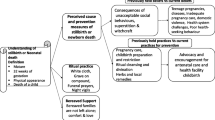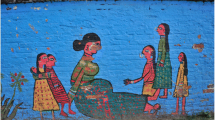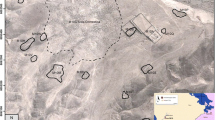Abstract
Maternal experience of emotional and physical disturbance during the postnatal period is a worldwide occurrence but may be interpreted differently according to cultural background. Little is known about different expressions and treatment of cultural phenomena during the postnatal period such as the affliction of Jinn possession in Arabic cultures. Jinn are considered to be evil spirits, which cause emotional and physical distress at times of vulnerability such as the postnatal period. The aim of this paper was to explore maternal experience of Jinn possession and draw parallels with Western interpretations of postnatal illness. Ten women in an Arabian Gulf state who had recently given birth and identified themselves as having Jinn possession were interviewed as to their experiences of Jinn possession. Mothers described the Jinn as evil spirits who cause symptoms such as sadness, anxiety and physical malaise during the postnatal period. Numerous risk factors for possession emerged such as lack of familial support, poverty and a traumatic birth. Clear parallels emerged between Western concepts of postnatal illness and Jinn possession Mothers in Muslim cultures may experience Jinn possession during the postnatal period, which reflects similar symptoms and aetiology to Western concepts of postnatal illness. With increasing multiculturalism in the UK, understanding the origins and perception of Jinn possession is important for health professionals working in Muslim communities here.
Similar content being viewed by others
References
Al Bahrani, M. A. (2004). An investigation of the help seeking process among Omani students. Unpublished doctoral thesis, Ohio University, USA. Accessed etd.ohiolink.ed.
Beck, C. (1999). Maternal depression and child behaviour problems: A meta-analysis. Journal of Advanced Nursing, 29, 623–629.
Braun, V., & Clarke, V. (2006). Using thematic analysis in psychology. Qualitative Research in Psychology, 3(2), 77–101.
Brown, S., & Lumley, J. (2000). Physical health problems after childbirth and maternal depression at 6 to 7 months postpartum. BJOG: An International Journal of Obstetrics & Gynaecology, 107, 1194–1201.
Bugdayi, R., Sanmaiz, C. T., Tezcanm, H., Kurt, A. O., & Oner, S. (2004). A cross sectional prevalence study of depression at various times after delivery in Mesin Province in Turkey. Journal of Women’s Health, 13(1), 63–68.
Chan, S., & Levy, V. (2004). Postnatal depression: A qualitative study of the experiences of a group of Hong Kong Chinese women. Journal of Clinical Nursing, 13, 120–123.
Chandran, M., Tharyan, P., Muliyil, J., et al. (2002). Post-partum depression in a cohort of women from a rural area of Tamil Nadu, India: Incidence and risk factors. British Journal of Psychiatry, 181, 499–504.
Creswell, J. W. (2007). Qualitative inquiry and research design: Choosing among five approaches (2nd ed.). Thousand Oaks/London/New Delhi: Sage Publications.
Cross-Sudworth, F., Williams, A., & Herron-Marx, S. (2011). Maternity services in multi-cultural Britain: Using Q methodology to explore the views of first- and second-generation women of Pakistani origin. Midwifery, 27, 458–468.
Dennis, C. L., & Hodnett, E. D. (2007). Psychosocial and psychological interventions for treating postpartum depression. Issue: Cochrane Database of Systematic Reviews Oct. 4.
Ghubash, R., & Eapen, V. (2009). Postpartum mental illness: Perspectives from an Arabian Gulf population 1. Psychological Reports, 105(1), 127–136.
Grime, J., & Pollock, K. (2004). Information versus experience: A comparison of an information leaflet on antidepressants with lay experience of experience of treatment. Patient Education and Counselling, 54(3), 361–368.
Haga, S. M., Ulleberg, P., Slinning, K., Kraft, P., Steen, T. B., & Staff, A. (2012). A longitudinal study of postpartum depressive symptoms: Multilevel growth curve analyses of emotion regulation strategies, breastfeeding self-efficacy, and social support. Archives of Women’s Mental Health, 15(3), 175–184.
Hanley, J., & Long, B. (2006). A study of Welsh mothers’ experiences of postnatal depression. Midwifery, 22(2), 147–157.
Henshaw, C. (2003). Mood disturbance in the early puerperium: A review. Archives of Women’s Mental Health, 6(2), 1434–1816.
Hildebrandt, K., & Young, M. (2007). Night waking in 6 month old infants and maternal depressive symptoms. Journal of Applied Developmental Psychology, 28(5–6), 493–498.
Kurzweil, S. (2008). Relational-developmental therapy group for postnatal depression. International Journal of Group Psychotherapy, 58(1), 17–34.
Leahy-Warren, P., & McCarthy, G. (2007). Postnatal depression: Prevalence. Mothers’ Perspectives and Treatments Archives of Psychiatric Nursing, 21(2), 91–100.
MacInnes, A. (2000). Findings of a community-based group for women with PND. Community Practitioner, 73(9), 754–756.
MacLachlan, M. (2006). Culture and health: A critical perspective towards global health (2nd ed.). Chichester: Wiley and Sons Ltd.
Milgrom, J., Schembri, C., Ericksen, J., Ross, J., & Gemmill, A. W. (2011). Towards parenthood: An antenatal intervention to reduce depression, anxiety and parenting difficulties. Journal of affective disorders, 130(3), 385–394.
Nhiwatiwa, S., Patel, V., & Acuda, S. (1998). Predicting postnatal mental disorder with a screening questionnaire: A prospective cohort study from a developing country. Journal of Epidemiology and Community Health, 52, 262–266.
Nielsen, D., Videbech, P., Hedegaard, M., Dalby, J., & Secher, N. J. (2000). Postpartum depression: Identification of women at risk. BJOG: An International Journal of Obstetrics & Gynaecology, 107(10), 1210–1217.
Oates, M., et al. (2004). Postnatal depression across countries and cultures: A qualitative study. The British Journal of Psychiatry, 184, s10–s16.
Office for National Statistics (2010). Population estimates for UK, England and Wales, Scotland and Northern Ireland, Population Density Tables 1981 to 2010.
Patel, V., Rodrigues, M., & de Souza, N. (2002). Gender, poverty and post-natal depression: A cohort study from Goa, India. American Journal Psychiatry, 159, 43–47.
Powell, A. (2003). Consciousness that transcends spacetime—its implication for the therapeutic process. Self and Society, 31(4), 27–44.
Powell, A. (2006). The contribution of spirit release therapy to mental health. Light, 126, 1.
Robertson, E., Grace, S., Wallington, T., & Stewart, D. E. (2004). Antenatal risk factors for postpartum depression: A synthesis of recent literature. General Hospital Psychiatry, 26(4), 289–295.
Sandelowski, M. (2010). What's in a name? Qualitative description revisited. Research in Nursing & Health, 33(1), 77–84.
Smith, J. C., Cumming, A., & Xeros-Constantinides, S. (2010). A decade of parent and infant relationship support group therapy programs. International Journal of Group Psychotherapy, 60(1), 59–89.
Spinelli, M. G. (2004). Maternal infanticide associated with mental illness: Preventions and the promise of saved lives. American Journal of Psychiatry Sept, 161(9), 1548–1557.
Stevenson, M. D., et al. (2010). Group cognitive behavioural therapy for postnatal depression; a systematic review of clinical effectiveness, cost-effectiveness and value of information analyses. Health Technology Assessment, Sep 14(44): 1–107, iii–iv.
Trivedi, J. K., Mishra, M., & Kendurkar, A. (2007). Depression among women in the South-Asian region: The underlying issues. Journal of Affective Disorders, 102(1–3), 219–225.
Vik, T., Grote, V., Escribane, J., Socha, J., Verduci, E., Fritsch, M., et al. (2009). Infantile colic, prolonged crying and maternal postnatal depression. Acta Paediatrica, 98, 1344–1348.
Conflict of interest
The authors declare no conflicts of interest with respect to the authorship and/or publication of this article.
Author information
Authors and Affiliations
Corresponding author
Rights and permissions
About this article
Cite this article
Hanely, J., Brown, A. Cultural Variations in Interpretation of Postnatal Illness: Jinn Possession Amongst Muslim Communities. Community Ment Health J 50, 348–353 (2014). https://doi.org/10.1007/s10597-013-9640-4
Received:
Accepted:
Published:
Issue Date:
DOI: https://doi.org/10.1007/s10597-013-9640-4




